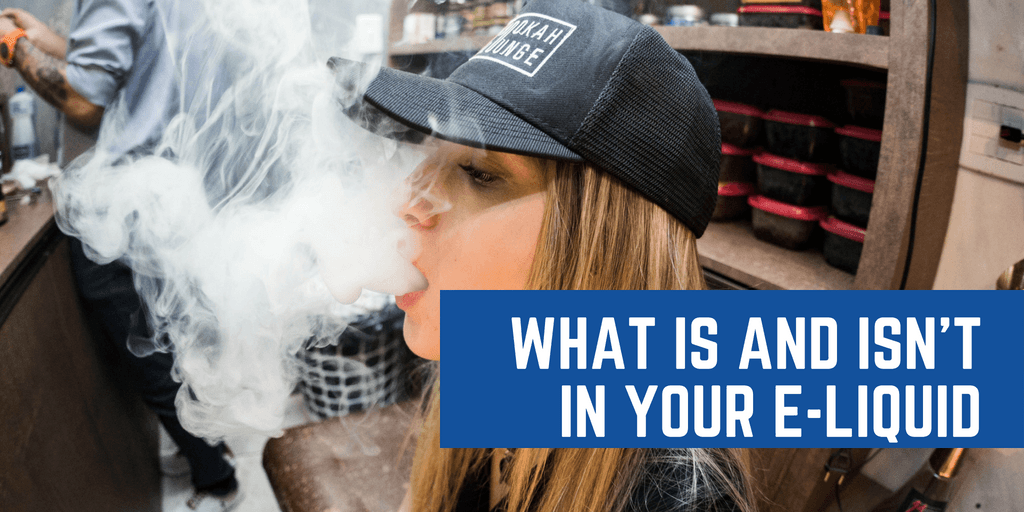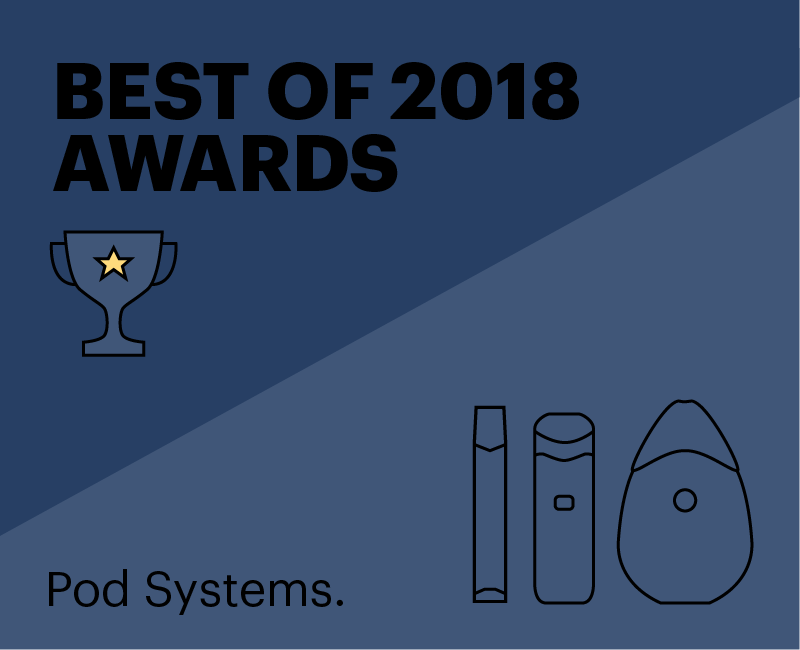This knowledge gap has created an environment where misinformation spreads rapidly, with certain media publications claiming that e-liquid contains all sorts of nasty additives and chemicals.
In reality, e-liquid is made up of four constituent parts with ingredients that are commonly found in products that you eat, drink and smoke regularly.
When a regular cigarette burns, it releases as many as 5,000 chemicals into your body. Many of these are poisonous and some are known to cause cancer.
While some of the long-term effects of vaping remain unclear, repeated studies have found that vaping is safer than smoking.
This position is endorsed by the National Academies of Sciences, Engineering and Medicine in the US and Public Health England, the Royal College of General Practitioners and the British Medical Association in the UK.
In this blog post, we detail exactly what is in your vape juice and try to dispel some of the myths about dangerous ingredients.
What is in your vape juice
E-liquid is made with four key components - vegetable glycerine (VG), propylene glycol (PG), flavourings and nicotine.
Vegetable glycerine (VG)
VG is used as a diluting agent to make your e-liquid thicker and more satisfying. Made with vegetable plant oils like palm, soy or coconut oil, pure VG is colourless and odourless and has a subtle sweet taste.
Most e-liquids are made using a combination of VG and PG. VG is thicker than PG and high VG e-liquids produce big puffy clouds of vapour. They also have a sweeter taste than PG-heavy vape juices.
Because they are thicker, high VG e-liquids leave a sticky residue on your vape. They also usually need a higher output device to vape them properly. ˜High VG e-liquids are typically made with a 70/30 or 80/20 VG/PG ratio.
Because it metabolizes differently than sugar, VG is found in a wide array of foodstuffs, particularly in low carbohydrate foods, where it adds sweetness and moisture. It is also used in many household products like lotions, shampoos and toothpaste.
Propylene glycol (PG)
PG is another diluent which, along with the nicotine, is responsible for that satisfying throat hit you get from your favourite vape juice flavour. It is a colourless and almost odourless type of alcohol.
Higher PG e-liquids are not as thick as high VG juices, and the clouds aren't as big either. But PG is partly responsible for the cigarette-like ˜throat hit you get immediately after inhaling your vape juice. This makes high PG e-liquids popular with smokers who have just switched to vaping.
Because it isn't as thick as VG, e-liquids with a high PG ratio will wick more easily, so they can be used with lower output devices. They can also produce richer, more complex flavours, but some people can have an unpleasant sensitivity to PG.
It is generally recognized as safe and non-toxic by the FDA and is used in a wide variety of products including food and pet food as well as cosmetics and pharmaceuticals. It is also used in a variety of other vaporizing products like asthma inhalers and commercial fog machines.
Nicotine
Nicotine is the addictive chemical found in cigarettes and is the most important ingredient for former smokers that have made the switch to vaping. Nicotine gets a bad name, probably because it is one of the most identifiable ingredients found in tobacco.
Four out of ten smokers wrongly think that nicotine causes most of the tobacco smoking-related cancer, but studies show that nicotine actually carries minimal risk of harm to health.
The problem with nicotine in cigarettes is not that the nicotine itself is harmful, but that the nicotine has an addictive quality which keeps smokers hooked on other harmful ingredients found in tobacco.
E-liquids do not produce tar or carbon monoxide, two of the most harmful elements of tobacco smoke. Other chemicals found in tobacco smoke are present in e-cigarettes but at much lower levels.
The way that nicotine interacts with your body is different with e-cigarettes. A study published in Nature found that nicotine delivery to the bloodstream from e-cigs was slower and lower than concentrations from regular cigarettes.
"The [e-cigarette] devices and liquid used in this study delivered one-third to one-fourth to amount of nicotine after five minutes of use," the paper concluded.
Flavourings
Flavourings are relatively straightforward. They're used by manufacturers to make your vape juice taste nice.
Of course there is an incredibly wide range of different flavourings that are used to create different tastes and effects. But it is important to remember that e-liquid makers will only ever use food grade flavourings or flavourings that are "generally recognized as safe" by the FDA, which means that the same flavourings are widely used in all sorts of food stuffs.
What Isn't in your e-liquid
Now we move on to try and dispel some of the myths surrounding what is in e-liquid.
Large amounts of diacetyl
Diacetyl is a chemical that's used in flavouring agents in many foods. With a buttery taste, it is widely used in microwavable popcorns and has been associated with a number of cases of a disease nicknamed "popcorn lung", prevalent among popcorn factory workers.
These workers inhaled massive quantities of the chemical while working on the factory floor as mixers of the butter flavourings.
Diacetyl is found in some, but by no means all e-liquids.
This lead to a stream of media reports linking vaping and popcorn lung. But, there has never been a case of a vaper experiencing popcorn lung. Since the media storm, many manufacturers have removed diacetyl from their e-liquids.
It is also worth noting that diacetyl is also found in regular combustible cigarettes. In fact, cigarettes contain at least 100 times as much diacetyl as e-liquids. Even at these levels, diacetyl does not pose a significant risk to human health.
Antifreeze
This is one of the most shocking and least well-researched myths about e-liquid. Headlines like "E-cigs Contain Antifreeze" are sure to get a reaction from vapers and the general public, but there is barely a morsel of truth behind them.
It comes from the fact that, as well as wide variety of foodstuffs and cosmetics, PG is also an ingredient in one types of antifreeze.
There are actually two types of common antifreeze. The one that's most widely used in automobiles is a mixture containing ethylene glycol, while the other is a mix of PG and water.
Unlike ethylene glycol, which is a potent cause of toxicity in humans, PG is "generally recognized as safe" by the FDA for foods and medications. It only causes toxic effects in very unusual circumstances.
Formaldehyde
The claim that vapers are being exposed to "hidden formaldehyde" is based on a study published in the New England Journal of Medicine.
This claim has been debunked several times, with authors claiming the study was completed at too higher temperatures, under "dry hit" conditions.
Any vapers that have experienced a dry hit will know that it is unpleasant, but relatively rare. When a vaper experiences a dry hit, they will normally stop vaping immediately. They would not continue vaping and inhaling the formaldehyde, which is also found in combustible cigarettes.






Leave a comment
This site is protected by hCaptcha and the hCaptcha Privacy Policy and Terms of Service apply.